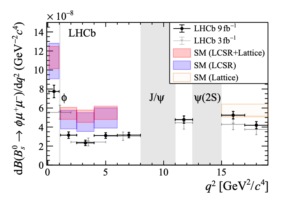The LHCb experiment at the LHC accelerator at CERN is again reporting measurements that appear to deviate from what the standard model of particle physics predicts. This could once again point to new, as yet unknown particles.
In a paper published today, the focus is on the decay of so-called Bs mesons to a phi-meson and two muons or two electrons. This is a very rare decay in itself, but in a certain energy range the experiment sees two to three times fewer muons than the handful predicted by theory.

Nikhef is heavily involved in LHCb, but has no direct involvement in this new analysis.
The identified muon deficit is not yet statistically hard enough to be called a discovery. It is statistically significant at 3.6 sigma, which means there is about a 1 in 3000 chance that it is a random outlier. Discoveries in particle physics require more than 5 sigma, to rule out any chance.
B-mesons are particles with two quarks of which there is a bottom (or beauty) quark. They can very occasionally form when two protons collide in the LHC accelerator. In the Bs meson, the b-quark is paired with a strange-quark (s).
Earlier this spring, LHCb reported an unexpected difference between electrons and their theoretically heavier counterpart muons. That difference too (work by Nikhef and others) was a clue, not a discovery, but interesting because it could indicate an unexpected force at play. More measurements could give a decisive answer.
In the media at the time there was speculation about a so-called leptoquark, a hypothetical extra particle that builds a bridge between quarks on the one hand and leptons on the other. In the standard model, the two exist separately.
For the current anomaly in the so-called branching ratio of Bs, the story is more subtle, says Nikhef particle physicist Patrick Koppenburg of LHCb. He points out that the uncertainty in the current measurements in this case arises mainly from theoretical uncertainties. Measuring more doesn’t really help with that. ‘More work by the theorists is needed on this decay to really pin down any difference between muons and electrons.’
Next Monday at the FPCP conference (online) in Shanghai, LHCb also publishes angular measurements of the same Bs decay. These, too, show a deviation from what theory predicts. “What’s particularly exciting is that all the clues are in the same direction,” says LHCb physics coordinator Niels Tuning, also of Nikhef.